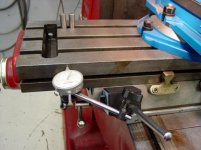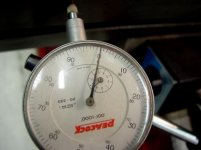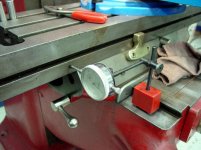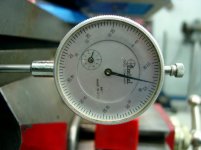silver star
Aluminum
- Joined
- Sep 19, 2013
- Location
- OK USA
Fair warning, I am a “new be” here.
However I have learned quite a bit reading from a lot of folks here.
I have a 30 year old high end import auto repair shop.
I shared that info only so you have some vision of my mechanical abilities.
Hopefully I have been able to post a picture of my BP.
I took a 1911 build class and learned to work with files 5 years back.
I quickly figured out how a mill would help make things easier.
I have Rheumatoid Arthritis which tells me to make things easier on my hands.
So…I contacted my machine shop owner about where to look for a mill.
I contacted his guy and bought what I could afford.
Seldom do I not research what I buy. However I went with a recommendation and here is what I got.



Serial Number J13938
# On end of knee # 25068
Info on Motor;
Master Electric Division
Reliance-Electrical Engineers
Columbus, Indiana
Spindle Speeds;
80/135/210/325
660/1115/1750/2720
173486-LR
Type - RA
Frame - 7420
H.P. ¾
Volts – 230
Cycles – 60
Amps – 6.3
Phase – 1
RPM – 1725
Code – G
6’5” tall, floor to top of motor
Table is 9” x 32”
Y travel is 9”
X travel is 24 ¼”
Base to Table has .007 movements
Table to Knee has .004 movements
Base to Knee has .001 movements
I was told to practice with stock material first but I could not wait and did some dove tail cuts on a new slide.
When the cuts were not correct, I started testing and found the dial for the X was on the Y and vise versa. Fixed that, re-cut and it has been running in competition with out a hiccup, yet. Ugly but runs.
Never the less, I shared that with you to let you know I have learned several lessons with this mill.
I hope I say this correct. I try to make conventional cuts when I can.
Sometimes I need to make a clime cut.
There is a certain point when I am moving table with the clime cut, the bit will grab the project and move it, table and all, in direction table is going, seeming like it just jumped a tooth.
I have .045 backlash on X & Y. Bearing in head is only noisy at hi speed.
Once I tried to drill a ¾” hole in a 2x2x4 block of steel.
After about ¼ depth I could not believe what I was seeing.
With all locks locked except spindle I continued and was convinced the table was moving kind of in a round pattern. Then the proof was in the hole, it was not 3/4.”
I found if I make small cuts to the target size it will work.
With that said, I have learned how to get around a lot of issues with this unit.
However, I need to get rid of these surprises.
I have read quite a bit here on the forum, rebuilding, restoring, etc, Bridgeport’s.
I have heard/read statements “cut your losses and buy a better one”.
I understand that, but there is one characteristic with this mill I really like.
It is small and I can do most of my work sitting in a chair.
That is important due to the fact in am 57 years old, have arthritis and a sciatic nerve that is pissed most of the time that I am standing.
I have been told by tool sales folks I cannot fix it, get a better one.
This info has only been over the phone. I really can’t tell if they want to sell another mill or not.
I am told I cannot get parts for this unit.
I have not been told if the parts can or cannot be made.
I’m thinking the knee, saddle, table mating surfaces would have to be resurfaced and scrapped for proper fit. But those areas remind me of a dovetail cut and I have a little experience in trying to fix something like that, and that worries me.
If you are still with me at this point here is my question.
I am asking this question here because I feel the answer will be short, maybe not sweet, but I am thick skinned.
Are there repair options or is it scrap?
Thank you for your time reading about my issue,
Suggestions, thoughts and/or complaints all welcome.
Michael in Oklahoma.
However I have learned quite a bit reading from a lot of folks here.
I have a 30 year old high end import auto repair shop.
I shared that info only so you have some vision of my mechanical abilities.
Hopefully I have been able to post a picture of my BP.
I took a 1911 build class and learned to work with files 5 years back.
I quickly figured out how a mill would help make things easier.
I have Rheumatoid Arthritis which tells me to make things easier on my hands.
So…I contacted my machine shop owner about where to look for a mill.
I contacted his guy and bought what I could afford.
Seldom do I not research what I buy. However I went with a recommendation and here is what I got.



Serial Number J13938
# On end of knee # 25068
Info on Motor;
Master Electric Division
Reliance-Electrical Engineers
Columbus, Indiana
Spindle Speeds;
80/135/210/325
660/1115/1750/2720
173486-LR
Type - RA
Frame - 7420
H.P. ¾
Volts – 230
Cycles – 60
Amps – 6.3
Phase – 1
RPM – 1725
Code – G
6’5” tall, floor to top of motor
Table is 9” x 32”
Y travel is 9”
X travel is 24 ¼”
Base to Table has .007 movements
Table to Knee has .004 movements
Base to Knee has .001 movements
I was told to practice with stock material first but I could not wait and did some dove tail cuts on a new slide.
When the cuts were not correct, I started testing and found the dial for the X was on the Y and vise versa. Fixed that, re-cut and it has been running in competition with out a hiccup, yet. Ugly but runs.
Never the less, I shared that with you to let you know I have learned several lessons with this mill.
I hope I say this correct. I try to make conventional cuts when I can.
Sometimes I need to make a clime cut.
There is a certain point when I am moving table with the clime cut, the bit will grab the project and move it, table and all, in direction table is going, seeming like it just jumped a tooth.
I have .045 backlash on X & Y. Bearing in head is only noisy at hi speed.
Once I tried to drill a ¾” hole in a 2x2x4 block of steel.
After about ¼ depth I could not believe what I was seeing.
With all locks locked except spindle I continued and was convinced the table was moving kind of in a round pattern. Then the proof was in the hole, it was not 3/4.”
I found if I make small cuts to the target size it will work.
With that said, I have learned how to get around a lot of issues with this unit.
However, I need to get rid of these surprises.
I have read quite a bit here on the forum, rebuilding, restoring, etc, Bridgeport’s.
I have heard/read statements “cut your losses and buy a better one”.
I understand that, but there is one characteristic with this mill I really like.
It is small and I can do most of my work sitting in a chair.
That is important due to the fact in am 57 years old, have arthritis and a sciatic nerve that is pissed most of the time that I am standing.
I have been told by tool sales folks I cannot fix it, get a better one.
This info has only been over the phone. I really can’t tell if they want to sell another mill or not.
I am told I cannot get parts for this unit.
I have not been told if the parts can or cannot be made.
I’m thinking the knee, saddle, table mating surfaces would have to be resurfaced and scrapped for proper fit. But those areas remind me of a dovetail cut and I have a little experience in trying to fix something like that, and that worries me.
If you are still with me at this point here is my question.
I am asking this question here because I feel the answer will be short, maybe not sweet, but I am thick skinned.
Are there repair options or is it scrap?
Thank you for your time reading about my issue,
Suggestions, thoughts and/or complaints all welcome.
Michael in Oklahoma.












 Way better to my sloppy painted '48 round ram M head.
Way better to my sloppy painted '48 round ram M head.